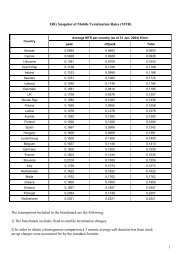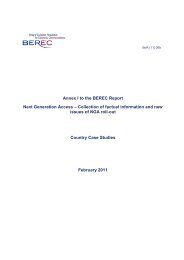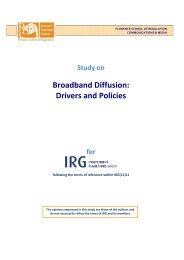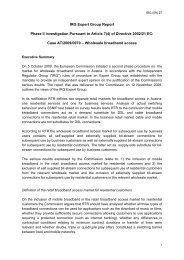You also want an ePaper? Increase the reach of your titles
YUMPU automatically turns print PDFs into web optimized ePapers that Google loves.
2. Introducti<strong>on</strong><br />
<strong>IRG</strong>-WG RA (<str<strong>on</strong>g>07</str<strong>on</strong>g>) <strong>WACC</strong> Master Doc<br />
The purpose of this document is to share experiences <strong>on</strong> the cost of capital calculati<strong>on</strong> and<br />
to discuss, am<strong>on</strong>g other things, the opportunity to adopt a divisi<strong>on</strong>al cost of capital for<br />
regulatory purposes. Moreover the document discusses how to identify a proper way to<br />
calculate the cost of capital for companies whose equity shares are not quoted <strong>on</strong> a stock<br />
exchange and publicly traded or when the nati<strong>on</strong>al financial market is not mature enough to<br />
estimate reliably the equity risk premium.<br />
The determinati<strong>on</strong> of the cost of capital is a crucial element in the regulatory process. When<br />
regulators set price limits for services or products supplied in those parts of industries where<br />
regulated firms have significant market power, they need to decide what would c<strong>on</strong>stitute a<br />
“fair” rate of return <strong>on</strong> the capital employed in the producti<strong>on</strong> of the regulated services. To do<br />
this, regulators need to assess the return that investors in these firms expect to earn in a<br />
competitive market.<br />
The key objective in setting an appropriate rate of return is to ensure that the regulated firm<br />
achieves a return sufficient to recover the opportunity cost of the capital employed in the<br />
producti<strong>on</strong> of the regulated services. This provides efficient price signals to market<br />
participants and to c<strong>on</strong>sumers and provides firms with the incentive for efficient investment in<br />
relevant infrastructure and services. Setting a rate of return below the opportunity cost of<br />
capital in the market could make investment unattractive to investors. Similarly, setting it too<br />
high would allow the regulated company to earn an excessive return, which would affect the<br />
competitiveness of the market and distort pricing signals to customers and investors,<br />
resulting in misallocati<strong>on</strong> of resources.<br />
Unfortunately there is no perfect theoretical answer to the problem of setting an appropriate<br />
rate of return <strong>on</strong> investments made by an operator. The <strong>WACC</strong> methodology, as defined<br />
below, is a widely accepted method for calculating the cost of capital. It is understood by both<br />
the finance community and the industry, and is c<strong>on</strong>sistent with the methodology used by<br />
many regulators.<br />
6







